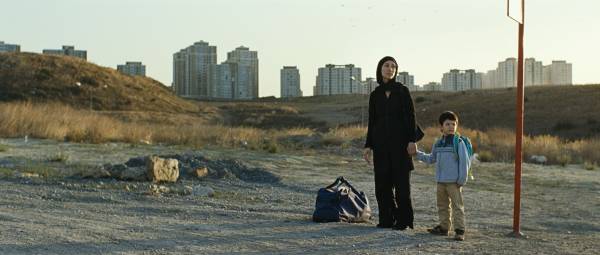
Umay (Sibel Kekilli) tries to build a new life with her son, Cem (Nizam Schiller), in gripping German-Turkish drama
WHEN WE LEAVE (DIE FREMDE) (Feo Aladag, 2010)
Symphony Space Leonard Nimoy Thalia
2537 Broadway at 95th St.
Sunday, March 20, 8:30; Sunday, March 27, 4:30; Sunday, April 3, 4:30
212-864-5400
www.whenweleave.com
www.symphonyspace.org
 Viennese actress Feo Aladag makes a powerful directorial debut with her heartbreaking melodrama, When We Leave. Inspired by her work with Amnesty International’s Stop Violence Against Women campaign, Aladag tells the story of a young mother, Umay (Head-On’s Sibel Kekilli), who leaves her abusive husband, Kemal (Ufuk Bayraktar), in Istanbul and returns with her son, Cem (Nizam Schiller), to her family in Germany. But her father, Kader (Settar Tanriogen), her mother, Halime (Derya Alabora), and especially her older brother, Mehmet (Tamer Yigit), insist she return to Kemal despite his mistreatment of her, since she has now brought shame to her family among the tight-knit Turkish community in Berlin. But as Umay refuses their demands and tries to put her life back together, Kader and Mehmet steadfastly turn away from her pleas to be accepted by them and instead conspire to return her and Cem to Kemal, no matter the cost. Winner of the Best Narrative Feature and Best Actress Award (for Kekilli) at the 2010 Tribeca Film Festival and Germany’s official entry for the 2011 Academy Awards for Best Foreign Language Film, When We Leave is a heart-tugging tale of misguided tradition, familial obligation, and the basic need to be loved. The film falters a bit as Umay continues going back to her parents time and time again, risking her life and that of her son, but it’s still a poignant, moving tale reminiscent of Abdullah Oguz’s 2007 film Mutluluk (Bliss), which brilliantly dealt with the theme of honor killings in Turkey. One of the most frightening aspects of the film is that the crimes of honor it deals with are all too real in numerous societies around the world, although Aladag wisely avoids getting overly preachy and pedantic. When We Leave is screening at Symphony Space as part of the weekly Thalia Film Sundays program on March 20, March 27, and April 3.
Viennese actress Feo Aladag makes a powerful directorial debut with her heartbreaking melodrama, When We Leave. Inspired by her work with Amnesty International’s Stop Violence Against Women campaign, Aladag tells the story of a young mother, Umay (Head-On’s Sibel Kekilli), who leaves her abusive husband, Kemal (Ufuk Bayraktar), in Istanbul and returns with her son, Cem (Nizam Schiller), to her family in Germany. But her father, Kader (Settar Tanriogen), her mother, Halime (Derya Alabora), and especially her older brother, Mehmet (Tamer Yigit), insist she return to Kemal despite his mistreatment of her, since she has now brought shame to her family among the tight-knit Turkish community in Berlin. But as Umay refuses their demands and tries to put her life back together, Kader and Mehmet steadfastly turn away from her pleas to be accepted by them and instead conspire to return her and Cem to Kemal, no matter the cost. Winner of the Best Narrative Feature and Best Actress Award (for Kekilli) at the 2010 Tribeca Film Festival and Germany’s official entry for the 2011 Academy Awards for Best Foreign Language Film, When We Leave is a heart-tugging tale of misguided tradition, familial obligation, and the basic need to be loved. The film falters a bit as Umay continues going back to her parents time and time again, risking her life and that of her son, but it’s still a poignant, moving tale reminiscent of Abdullah Oguz’s 2007 film Mutluluk (Bliss), which brilliantly dealt with the theme of honor killings in Turkey. One of the most frightening aspects of the film is that the crimes of honor it deals with are all too real in numerous societies around the world, although Aladag wisely avoids getting overly preachy and pedantic. When We Leave is screening at Symphony Space as part of the weekly Thalia Film Sundays program on March 20, March 27, and April 3.

 Up in the wilderness of Mount Chonan, far away from civilization, young orphan Haejin (Huang Hae-Jin) and Kibong (Won-Sop Sin), a refugee from “the world,” learn about the self and the other from aging master Hyegok (Pan-Yong Yi) as they contemplate the Buddhist philosophy of life and death. First-time Korean filmmaker Bae Yong-kyun wrote, directed, photographed, and edited this meditative, moving story over several years during the turbulent mid-to-late 1980s, when student unrest and unhappy workers helped end the Chun Doo Hwan regime. Thus, the freedom the characters are striving for is not only the Zen freedom from attachment and earthly ties but the political freedom from an oppressive leadership. Bae, who is also a painter, imbues the film with beautiful photography and gorgeously framed shots. It might be slow-paced, but it’ll draw you in if you’re willing to free your mind of material concerns. The film won the Golden Leopard at the Locarno Film Festival and gained international notoriety when Sight and Sound magazine named it in 1992 one of the ten best films ever made; it was also the first Korean film to be released theatrically in the United States.
Up in the wilderness of Mount Chonan, far away from civilization, young orphan Haejin (Huang Hae-Jin) and Kibong (Won-Sop Sin), a refugee from “the world,” learn about the self and the other from aging master Hyegok (Pan-Yong Yi) as they contemplate the Buddhist philosophy of life and death. First-time Korean filmmaker Bae Yong-kyun wrote, directed, photographed, and edited this meditative, moving story over several years during the turbulent mid-to-late 1980s, when student unrest and unhappy workers helped end the Chun Doo Hwan regime. Thus, the freedom the characters are striving for is not only the Zen freedom from attachment and earthly ties but the political freedom from an oppressive leadership. Bae, who is also a painter, imbues the film with beautiful photography and gorgeously framed shots. It might be slow-paced, but it’ll draw you in if you’re willing to free your mind of material concerns. The film won the Golden Leopard at the Locarno Film Festival and gained international notoriety when Sight and Sound magazine named it in 1992 one of the ten best films ever made; it was also the first Korean film to be released theatrically in the United States.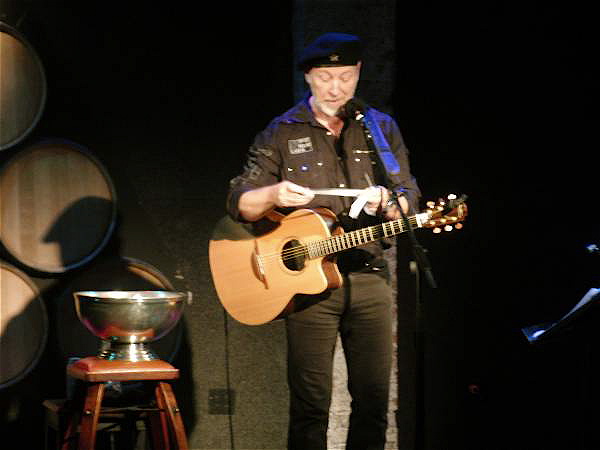
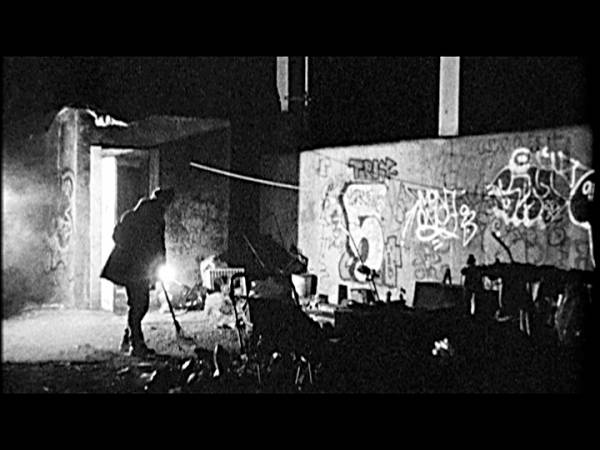
 The award-winning documentary Dark Days takes a frightening look at a community of homeless men and women — many of them former or current crack users — who live in the Amtrak tunnels beneath Penn Station. They sleep in tents, cardboard shacks, and small plywood shanties, some of which have been painted and decorated. As the belowground residents shave, cook, play with their pets, and take showers under leaking pipes, trains speed by, and rats scavenge through the countless mounds of garbage. At times some of the men venture aboveground (“up top”) to go through trash cans, mostly looking for recyclable bottles and junk items they can resell. First-time filmmaker Marc Singer became a part of this colony for two years (he initially went down to help the people, not to film them), getting the residents to open up and tell their fascinating stories, which turn out to be filled with a surprising zest for living. In fact, all of the underground shooting was completed with the help of the subjects themselves acting as the crew when they were not on camera. DJ Shadow composed the haunting music for this strangely enriching look at a mysterious, truly terrifying part of New York City. Dark Days kicks off the True Crime New York series at the Maysles Cinema in Harlem on March 21 and will be introduced by former mayor David Dinkins; the special event, curated by Sylvia Savadjian, will be followed by a discussion with Singer and Mary Brosnahan, the executive director of the Coalition for the Homeless. The series continues March 22, 24, and 26 with Alex Gibney’s Client 9: The Rise and Fall of Elliot Spitzer and March 23, 25, and 27 with Charles Ferguson’s Oscar-winning Inside Job. There will be postscreening Q&As on March 24 with Gibney and March 25 with activist Carl Dix, with more to be announced.
The award-winning documentary Dark Days takes a frightening look at a community of homeless men and women — many of them former or current crack users — who live in the Amtrak tunnels beneath Penn Station. They sleep in tents, cardboard shacks, and small plywood shanties, some of which have been painted and decorated. As the belowground residents shave, cook, play with their pets, and take showers under leaking pipes, trains speed by, and rats scavenge through the countless mounds of garbage. At times some of the men venture aboveground (“up top”) to go through trash cans, mostly looking for recyclable bottles and junk items they can resell. First-time filmmaker Marc Singer became a part of this colony for two years (he initially went down to help the people, not to film them), getting the residents to open up and tell their fascinating stories, which turn out to be filled with a surprising zest for living. In fact, all of the underground shooting was completed with the help of the subjects themselves acting as the crew when they were not on camera. DJ Shadow composed the haunting music for this strangely enriching look at a mysterious, truly terrifying part of New York City. Dark Days kicks off the True Crime New York series at the Maysles Cinema in Harlem on March 21 and will be introduced by former mayor David Dinkins; the special event, curated by Sylvia Savadjian, will be followed by a discussion with Singer and Mary Brosnahan, the executive director of the Coalition for the Homeless. The series continues March 22, 24, and 26 with Alex Gibney’s Client 9: The Rise and Fall of Elliot Spitzer and March 23, 25, and 27 with Charles Ferguson’s Oscar-winning Inside Job. There will be postscreening Q&As on March 24 with Gibney and March 25 with activist Carl Dix, with more to be announced.
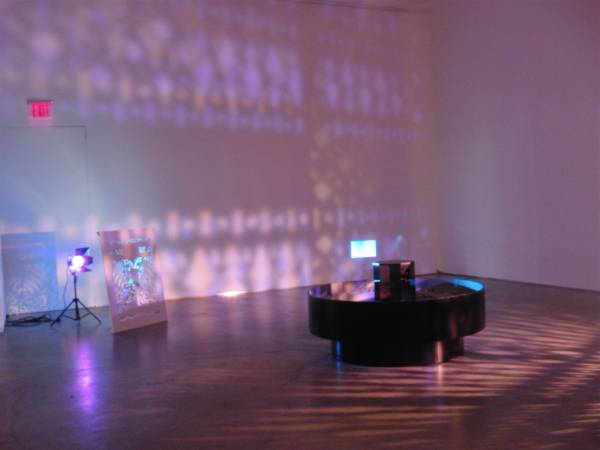
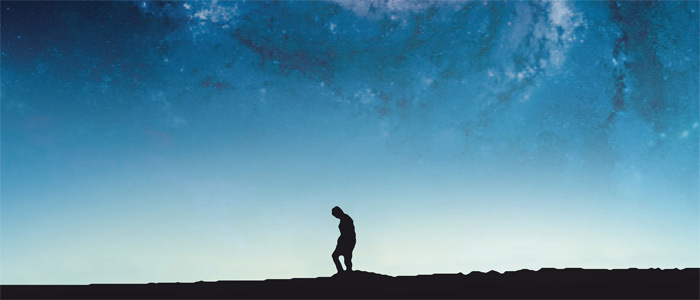
 Master documentarian Patricio Guzmán’s Nostalgia for the Light is a brilliant examination of memory and the past, one of the most intelligent and intellectual films you’re ever likely to see. But don’t let that scare you off — it is also a vastly entertaining, deeply emotional work that will blow you away with its stunning visuals and heartbreaking stories. Guzmán, who chronicled the assassination of Salvador Allende and the rise of Augusto Pinochet in the landmark three-part political documentary The Battle of Chile, this time visits the Atacama Desert in his native Chile, considered to be the driest place on Earth. Situated ten thousand feet above sea level, the desert is home to La Silla and Paranal Observatories, where astronomers come from all over the world to get unobstructed views of the stars and galaxies, unimpeded by pollution or electronic interference. However, it is also a place where women still desperately search for the remains of their loved ones murdered by Pinochet’s military regime and hidden away in mass graves. In addition, archaeologists have discovered mummies and other fossilized bones dating from pre-Columbian times there. Guzmán seamlessly weaves together these three journeys into the past — as astronomers such as Gaspar Galaz and Luis Hernandez note, by the time they see stars either with the naked eye or through the lens of their massive telescopes, the celestial bodies have been long dead — creating a fascinating narrative that is as thrilling as it is breathtaking. Constructing a riveting tale of memory, Guzmán speaks with architect Miguel Lawner, who draws detailed maps of the Chacabuca desert concentration camp where he and so many other political prisoners were held; Valentina, a young astronomer whose grandparents had to give up her parents in order to save her when she was a baby; archaeologist Lautaro Nunez, who digs up mummies while trying to help the women find “los desaparecidos”; and Victoria and Violeta, who regularly comb the barren landscape in search of their relatives. “I wish the telescopes didn’t just look into the sky but could also see through the earth so that we could find them,” Violeta says at one point. Spectacularly photographed by Katell Dijan, Nostalgia for the Light is a modern masterpiece, an unparalleled cinematic experience that has to be seen to be believed. (Guzmán will be at the IFC Center for the 8:10 screenings on Friday and Saturday night to talk about the film, and BAMcinématek will be presenting
Master documentarian Patricio Guzmán’s Nostalgia for the Light is a brilliant examination of memory and the past, one of the most intelligent and intellectual films you’re ever likely to see. But don’t let that scare you off — it is also a vastly entertaining, deeply emotional work that will blow you away with its stunning visuals and heartbreaking stories. Guzmán, who chronicled the assassination of Salvador Allende and the rise of Augusto Pinochet in the landmark three-part political documentary The Battle of Chile, this time visits the Atacama Desert in his native Chile, considered to be the driest place on Earth. Situated ten thousand feet above sea level, the desert is home to La Silla and Paranal Observatories, where astronomers come from all over the world to get unobstructed views of the stars and galaxies, unimpeded by pollution or electronic interference. However, it is also a place where women still desperately search for the remains of their loved ones murdered by Pinochet’s military regime and hidden away in mass graves. In addition, archaeologists have discovered mummies and other fossilized bones dating from pre-Columbian times there. Guzmán seamlessly weaves together these three journeys into the past — as astronomers such as Gaspar Galaz and Luis Hernandez note, by the time they see stars either with the naked eye or through the lens of their massive telescopes, the celestial bodies have been long dead — creating a fascinating narrative that is as thrilling as it is breathtaking. Constructing a riveting tale of memory, Guzmán speaks with architect Miguel Lawner, who draws detailed maps of the Chacabuca desert concentration camp where he and so many other political prisoners were held; Valentina, a young astronomer whose grandparents had to give up her parents in order to save her when she was a baby; archaeologist Lautaro Nunez, who digs up mummies while trying to help the women find “los desaparecidos”; and Victoria and Violeta, who regularly comb the barren landscape in search of their relatives. “I wish the telescopes didn’t just look into the sky but could also see through the earth so that we could find them,” Violeta says at one point. Spectacularly photographed by Katell Dijan, Nostalgia for the Light is a modern masterpiece, an unparalleled cinematic experience that has to be seen to be believed. (Guzmán will be at the IFC Center for the 8:10 screenings on Friday and Saturday night to talk about the film, and BAMcinématek will be presenting